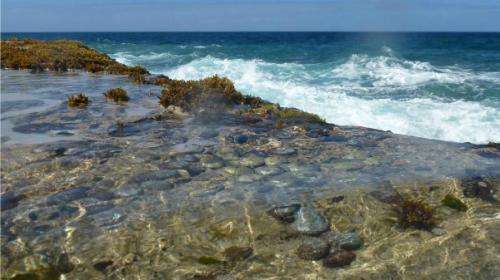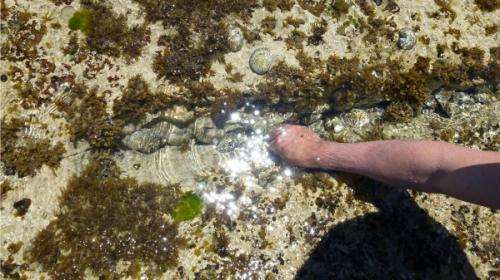Kalbarri abalone gets helping hand

Department of Fisheries staff and Kalbarri fishermen have released 24,000 Roe's abalone (Haliotis roei) onto reef platforms along the cliffs north of Kalbarri, to restock a population decimated by the marine heat wave of 2010-11.
The heat wave killed 99.9 per cent of the Roe's abalone population in the area, which was once a productive commercial and recreational fishery that has now been closed to fishing indefinitely.
The devastation prompted WA Fisheries scientists to embark on a long-term project to reintroduce abalone to the area.
WA Fisheries research scientist Lachlan Strain says the first step was translocating 6000 adult Roe's abalone from Lucky Bay, south of Kalbarri, which was less severely affected by the heat wave.
"We translocated the animals from Lucky Bay in 2011-12 to five reef-top platforms north of the Murchison River—areas where historically large populations resided," Dr Strain says.
"Since then we have refined the transport and harvest methodologies, which has dramatically improved the survival of translocated animals."
Rather than place added pressure on the Lucky Bay population, in 2013 researchers began harvesting adult abalone from the Perth metropolitan fishery, and transporting them to Kalbarri's notoriously wave-pounded coast when weather permitted—a move which resulted in the translocation of another 3000 animals.
This year they have also translocated 15,000 juvenile abalone bred in aquaculture facilities to further reduce the impact on wild populations.

Dr Strain says monitoring has revealed good survival rates among the translocated animals given the harsh conditions at the release sites.
However, monitoring control sites every six months has yet to reveal signs of newly settled abalone.
"Because of the mortality event's severity, if we do nothing to assist recovery then it could be decades if not longer before we see any signs of natural population recovery," Dr Strain says.

Given the remote location and severity of swells, Dr Strain says researchers have relied on local fishermen to access the reef platforms, during the right weather conditions, to hand release the animals.
"Kalbarri fisherman John Craike and other locals have been instrumental in helping this project to succeed," Dr Strain says.
He expects translocations to continue for another three to five years and hopes, with continued community involvement, they will proceed well into the future.
Provided by Science Network WA
















